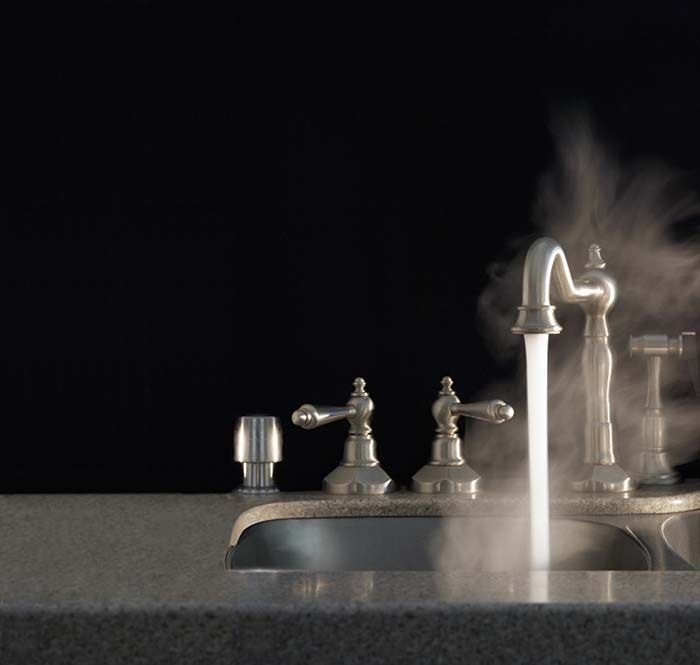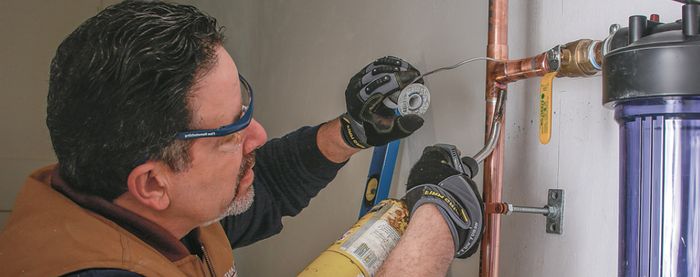Hot Water Now
Recirculation systems eliminate a long wait at the tap and save thousands of gallons of water.

Synopsis: If your morning routine includes a walk to the bathroom to turn on the shower before heading to the kitchen to make breakfast while you wait for the shower water to get hot, you’re not alone. Most conventionally plumbed houses have lethargic hot-water delivery systems that waste your time, your water, and your money. The good news is that the solution is simple for new houses or old. Hot-water recirculation is not new technology; it has been used for decades in commercial buildings. The concept is easy to understand: Hot water circulates through the plumbing so that it is there when you need it. The details, however, are a little more complicated. In this article, contributing editor Scott Gibson explains the basics of hot-water recirculation for new and existing homes and discusses some of the details that make some systems more convenient and energy-efficient than others.
It takes about 90 seconds for hot water to reach the shower in my bathroom. As I wait, a lot of water goes down the drain.
This waste can add up to thousands of gallons of water each year—and a lot of money— which makes a good case for a plumbing alternative known as hot-water recirculation.
When properly designed and used, hot-water recirculation systems add only marginally to construction costs. They are inexpensive to operate; they virtually eliminate wasted water, and they provide instant hot water. A recirculation system can be added to an existing house pretty easily, too.
Although point-of-use water heaters are another option for bringing hot water to the tap faster, recirculation systems are a far more practical, whole-house solution.
Recirculation reduces waste and wait
In conventionally plumbed houses, water is piped through trunk and branch lines. Trunk lines, usually 3 ⁄4-in. pipe, carry water to areas in the house where it is needed. Branch lines, usually 1 ⁄2-in. pipe, extend from the trunk lines to individual fixtures and appliances.
The problem is that when hot water is not being used, it rests in the lines and cools. Then, when hot water is needed, the cool water that was resting in the hot-water lines flows down the drain, wasting water while you wait for hot water to reach the tap.
A few different types of recirculation systems can solve this problem. Common to most of them is an electric pump that circulates hot water through a combination trunk/return line that carries unused hot water back to the water heater. Circulating through the trunk line, hot water is only as far away as the branch line is long, minimizing both the waste and the wait.
Where hot-water recirculation systems differ is in the details. The pumps can run continuously; only when timer and/or thermostat settings permit (with time-and-temperature systems); or when activated manually (with on-demand systems).
Efficiency varies with each system
The simplest recirculation system consists of a small, continuously operating pump. Hot water circulates slowly (low-flow pumps circulate as little as 2 ⁄10 gal. per minute) through the trunk lines and returns to the water heater if unused.
A low-volume pump may require as little as 25 watts of electricity. However, the trunk lines effectively become an extension of the water heater, and heat loss can be significant.
To make the system more efficient, a timer can be used to control when hot water is pumped around the loop. If hot water is needed mainly between 6:30 a.m. and 8 a.m., then the timer can be set to run the pump only during those hours. A thermostat, or more accurately, an adjustable aquastat that monitors water temperature and turns the pump on and off, further reduces operating costs. Hot water flows only when both time and temperature settings are right. Time-and-temperature pumps including an aquastat cost less than $300.
How it works
New Homes
A hot-water recirculation system isn’t much different than the plumbing in most homes. Instead of letting hot water rest and cool in the pipes, a pump pushes it through the trunk lines, and a dedicated return line circulates unused hot water back to the water heater. As a result, hot water is always close to the tap. To be efficient, hot-water lines should be well insulated.
A crossover valve makes retrofits work
What about homes that don’t have a dedicated return line? Given that installing one in an existing house might be impractical, the solution is a one-way, temperature-actuated crossover valve that allows the cold-water
trunk line to become a hot-water return line temporarily (drawing right). Although some retrofit systems operate on time-and-temperature principles and some on-demand, the concept
is similar.
When the pump is activated, hot water circulates through the trunk lines. The crossover valve, which opens when the water temperature falls below 95ºF, typically is installed below the sink farthest from the water heater. When open, the valve allows cool water resting in the hot-water lines to flow into the cold-water lines. When the water reaches a set temperature, usually 105ºF, the valve closes.
Crossover valves don’t require power, but pumps do. Some pumps are installed at the water heater, others with the valve below a sink. The price difference between systems is insignificant, so the availability of power
under a sink or at the water heater may be reason enough to choose one system over another.
Unfortunately, solving one problem can create another in retrofit situations. By allowing warm water to run into the cold-water lines, crossover valves can create the same problem for cold water that you’re trying to eliminate for hot water: If you draw a glass of water while the pump is running, it might not be cold. A pump and a valve for a retrofit cost less than $300. Each hot-water trunk line requires its own pump and valve.
Details maximize efficiency
For convenience, a time-and-temperature system may seem hard to beat. On-demand systems really don’t eliminate the wait for hot water.
However, Gary Klein, an energy specialist with the California Energy Commission, says on-demand systems can be the most energy-efficient. The pump moves water quickly to heat the hot-water lines and can be turned off as soon as the water has reached an appropriate temperature. According to Klein, on-demand systems used only a few minutes each day require the least amount of energy to operate the pump and, more importantly, to heat the water.
For any type of recirculation system to be efficient, it must be used and designed properly. The best systems have short hot-water loops, ideally less than 10 ft., and well-insulated piping. If energy savings are a concern, insulating the hot-water lines is money well spent.
How it works
Existing Homes
Similar to a system in new construction, a pump circulates hot water through the trunk lines. The pump may be located at the water heater or beneath a sink. Instead of a dedicated return line, a valve installed between hot and cold branch lines allows the cold-water trunk line to become the hot-water return.
Two energy-efficient ways to get hot water faster
Time-and-temperature recirculation
Equipped with both an adjustable timer and an aquastat that monitors water temperature, this type of recirculation system pumps hot water into the supply loop at designated times of the day.
|
Pros |
Cons |
|
• Reduces wasted water and eliminates the wait for hot water. • Adjustable to specific hot-water needs of the household. • Override function allows the system to be charged with hot water at any time. |
• An overused system can increase net energy use significantly. • When plumbed as a retrofit at the faucet farthest from the water heater, the system may warm cold-water lines. |
On-demand recirculation
This type of system uses a pump to operate only when someone wants hot water. The pump can be activated manually, or automatically by a motion detector.
| Pros | Cons |
|
• Reduces wasted water and the wait for hot water. • When used properly, can reduce net energy use. • Retrofit system has a less significant crossover of hot water into cold water lines. |
• It’s not always instant. There still can be a wait for hot water after the pump has been activated; the length of time depends on plumbing configuration. • Retrofits require a pump and a power source at the end of each hot-water loop. |
Point-of-use heaters
Recirculation is a holistic cure for a lethargic hot-water system. Point-of-use heaters, installed only where they are needed, are another way of dealing with the problem in specific locations. Several types of these water heaters are available, including instant hot-water dispensers, under-counter water heaters, and small tankless heaters.
• Hot-water dispensers are a handy kitchen aid, but they’re not as useful for making shower water hot. Dispensers can produce up to 100 cups of near-boiling water per hour and cost between $100 and $400.
• Undercounter water heaters hold 2 gal. to 4 gal. of water and cost as much as $500. A slightly larger model, such as a 15-gal. unit fits in a closet and can be a good solution for an in-law apartment or other occasionally used space. As a fix for slow hot water at a frequently used shower, however, its benefits are likely to be diminished by high operating costs.
• Small, tankless water heaters are another option for a bathroom or kitchen far from the main water heater. Because tankless units heat water only when it’s needed, you don’t pay to keep stored water hot. Gas-fired models (starting around $600) are more efficient and produce more hot water than electric heaters. However, indoor installation is limited because it requires a vent and a gas line. An electric tankless water heater (starting around $500) that produces enough hot water for a shower may require a 60-amp breaker at 240 volts.
From Fine Homebuilding #183
To view the entire article, please click the View PDF button below.








